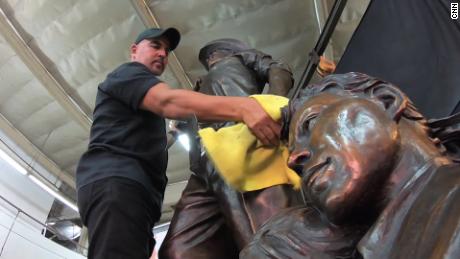When he's done, a bronze statue portraying a Mexican migrant and his family will be standing on a pedestal near the downtown Los Angeles spot where the city was founded.Los Angeles City Councilman Jose Huizar says when it's unveiled Sunday, the 19-foot-tall sculpture near the city's historic Olvera Street will be the first monument to honor the migrants known as braceros — a group he says officials felt it's particularly important to recognize."Their story hasn't been told," he says.Millions of guest workers came to the United States from Mexico under a government program that lasted for decades. They were known as braceros — a term for manual laborers stemming from "brazo," the Spanish word for "arm."The program began with an executive order issued in 1942 amid World War II-era labor shortages and ended in 1964, according to the Bracero History Archive.It's a story Huizar says he knows well. His family lived it."My father was a bracero. All my uncles were braceros. And they tell me many stories of the time they would come. They tell me about the sacrifices they made, sometimes they would go without water during the day, the barracks they put them in, terrible barracks, the living conditions were horrible," he says. "But despite these sacrifices, they were appreciative of the opportunity, because they were able to get a little money, (and) send it back to their families."The braceros' story is also personal for the artist behind the monument, which portrays a father standing tall beside his wife and child."My stepfather, who pretty much raised me and taught me the work ethic and everything I am today, he was a bracero," Medina told CNN.Speaking from his studio this week, Medina said the sculpture has an even bigger message than the story of braceros themselves: "being able to talk about the immigrant, their contributions then, and now, and tomorrow." Leobardo Villa says he sees himself in Medina's sculpture. The 85-year-old first came to the United States as a bracero working in California's tomato fields decades ago. Every day they'd start before dawn and work until 7 p.m., he says. His uncle would tell them to stay in the fields "until the crickets started to chirp.""It was very difficult for people who weren't used to working in the fields," he says. "They got blisters on their hands."Another ex-bracero, 82-year-old Ramon Zapata, says the mother and child depicted in the monument speak to him."It was so difficult to leave your family alone," says Zapata, who came to the US as part of the program three times, picking cotton and harvesting tomatoes in California and working in fields in Colorado. Read More – Source
Leobardo Villa says he sees himself in Medina's sculpture. The 85-year-old first came to the United States as a bracero working in California's tomato fields decades ago. Every day they'd start before dawn and work until 7 p.m., he says. His uncle would tell them to stay in the fields "until the crickets started to chirp.""It was very difficult for people who weren't used to working in the fields," he says. "They got blisters on their hands."Another ex-bracero, 82-year-old Ramon Zapata, says the mother and child depicted in the monument speak to him."It was so difficult to leave your family alone," says Zapata, who came to the US as part of the program three times, picking cotton and harvesting tomatoes in California and working in fields in Colorado. Read More – Source





